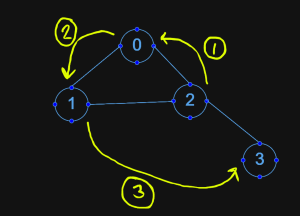Breadth-First Search (BFS) Explained
Breadth-First Search (BFS) is a fundamental graph traversal algorithm. It explores the graph level by level, starting from a given source node and expanding outwards to all its neighbours before moving on to the next level.
Example:
INPUT :
[
[0, 1, 1, 0],
[0, 0, 1, 0],
[1, 0, 0, 1],
[0, 0, 0, 1]
] , 2

OUTPUT:
2 -> 0 -> 1 -> 3
Key Concepts
- Graph Structure:
BFS works on graphs (bothdirectedandundirected) as well as trees. - Level-Order Traversal:
Nodes are visited in order of their distance from the starting node (i.e., by increasing number of edges). - Queue Data Structure:
BFS uses a FIFO (first-in, first-out) queue to keep track of nodes to visit next.
How BFS Works
- Initialization:
- Mark the starting node as visited.
- Enqueue the starting node.
- Iteration:
- Dequeue a node from the front of the queue.
- Process the current node (e.g., record its value).
- For each unvisited neighbour of the current node:
- Mark the neighbour as visited.
- Enqueue the neighbour.
- Termination:
- Repeat the iteration until the queue is empty. At this point, all reachable nodes from the starting node have been visited.
Time and Space Complexity
Time Complexity: O(V + E)
- V = number of vertices
- E = number of edges
- Every vertex and edge is processed once.
Space Complexity: O(V)
- In the worst case, the queue holds all vertices in the graph.
Applications of BFS
- Shortest Path:
BFS is ideal for finding the shortest path in unweighted graphs. - Level Order Traversal:
In trees, BFS performs a level order traversal. - Connected Components:
BFS can help determine the connected components in a graph. - Web Crawlers:
Used to explore the web layer by layer starting from a seed URL.
Category:- Graphs
- Searching
Programming Language: - Java
Reference Link:
https://drawtocode.vercel.app/problems/breadth-first-search
Java
Output:
Loading component...
Loading component...